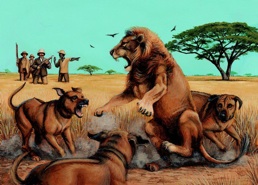The roots of Rhodesian Ridgeback breed can be traced from
a hunting dog, which was able to hunt large animals of prey.
These dogs are prized for their continued loyal temperament,
making them the perfect companion for the tribes, which are
constantly moving from place to place, encountering danger
at every turn. That were the tribes of the Hottentots -
low-growing bush residents of South Africa.
Over the centuries Hottentots moved everything to the
south, an area of Tanzania, Zambia and Rhodesia (now Zimbabwe).Among the animals that traveled with Hottentots, were hunting dogs with ridge on the back. Hottentot dog is likely to be considerably smaller than Ridgebacks today - a little more than 46 cm at the withers. The dog was described by historian George Makkoulhilom as a terrible creature with a body resembling the body of a jackal, and the fur on his back, growing in the opposite direction, but at the same time selflessly devoted man to animals. In what external data dogs were improved by crossbreeding with dogs tribe Bakalahari having the type of Greyhound, which undoubtedly improved the quality and hunting dogs Hottentots.
In 1651 the Dutch East India Company sent Jan van Riebeeck to build a settlement at the Cape of Good Hope in South Africa, where he arrived April 6, 1652. Dutch policy with regard to domestic animals was reduced while attempts to develop new breeds by crossing imported from Europe, with local breeds, rather than through the introduction of a purely European lines of rocks in new countries.In South Africa it has led to the removal of red-brown Afrikaner dogs, which are precursors of the present day Ridgeback.
Figure hunting in 1882 from the book by Frederick Seloua Travel and Adventure in Africa (the book is in the U.S. National Archives)
Settlers hunted a lot and, naturally, tried to improve the quality of Hottentot dogs by crossing with some European breeds.

Cornelius Van Rooeyn with his beloved dog named Vlaam
Next, perhaps the most crucial step in the breeding of the breed occurred in 1870 when missionary Charles Helm brought two dogs with ridges - Powder and Lorna - from Svellindami in Matabelend (Rhodesia). Among people who visited the house of Charles Helm was a famous hunter of that time Cornelius Van Rooy who lived in Mangve, 90 km from the Cape of Good Hope, and also had several hunting dogs.
When Van Rooy saw two females, brought by Charles Helm, he admired their physical, security and hunting qualities, which led to an agreement with Charles Helmo of mating with females hunting dogs Cornelius Van Rooy. Were the result of crossing a dog with a ridged back, red fur and a tail of modern Ridgeback, which laid the foundation for purposeful breeding of dogs by Cornelius Van Rooyenom in the next 35 years, in order to bring a dog capable of hunting lions, as did her ancestors.
Francis Richapd Barnes, then living in Bulawayo bought my first Ridgeback in 1910 by Graham Stacey, named Dingo, whose roots originated from Ridgeback van Rooy. Somewhat later, Barnes got another Ridgeback - bitch Judy, by launching the famous line Eskdeylsk Ridgeback.

Francis Richard Barnes and his dog Dingo
Barnes was keenly aware of the need to introduce the breed standard, as are constantly faced with Ridgebacks different size, coat and color.
In 1922 a group of seven people founded the Rhodesian Ridgeback Club (lion dog). In the same year he released the first breed standard, which, according to Barnes, was largely borrowed from the Dalmatian standards.
In fact, this standard served the Ridgeback and remained virtually unchanged for the most important points, having undergone only minor changes, limiting the permissible coat color and allow the white spots only on the chest and toes.
September 29, 1924 Rhodesian Ridgeback as a breed was officially recognized by the South African Kennel Union (SAKU - now KUSA).
In November 1955, the American Kennel Club admitted the Rhodesian Ridgeback to its Stud Book as the 112th breed to be accorded AKC registration facilities. TheRhodesian Ridgeback is shown in the Hound Group (GR, II). Since the recognition of the Rhodesian Ridgeback by the American Kennel Club, interest in the breed has increased in the United States.







